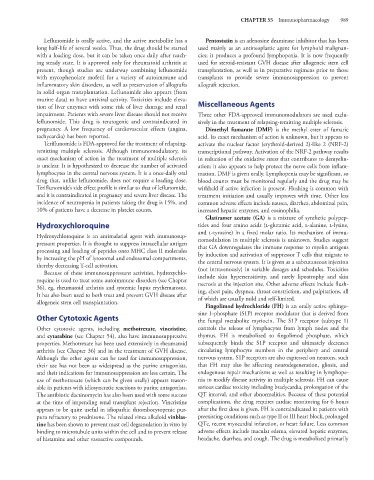Page 1003 - Basic _ Clinical Pharmacology ( PDFDrive )
P. 1003
CHAPTER 55 Immunopharmacology 989
Leflunomide is orally active, and the active metabolite has a Pentostatin is an adenosine deaminase inhibitor that has been
long half-life of several weeks. Thus, the drug should be started used mainly as an antineoplastic agent for lymphoid malignan-
with a loading dose, but it can be taken once daily after reach- cies; it produces a profound lymphopenia. It is now frequently
ing steady state. It is approved only for rheumatoid arthritis at used for steroid-resistant GVH disease after allogeneic stem cell
present, though studies are underway combining leflunomide transplantation, as well as in preparative regimens prior to those
with mycophenolate mofetil for a variety of autoimmune and transplants to provide severe immunosuppression to prevent
inflammatory skin disorders, as well as preservation of allografts allograft rejection.
in solid organ transplantation. Leflunomide also appears (from
murine data) to have antiviral activity. Toxicities include eleva-
tion of liver enzymes with some risk of liver damage and renal Miscellaneous Agents
impairment. Patients with severe liver disease should not receive Three other FDA-approved immunomodulators are used exclu-
leflunomide. This drug is teratogenic and contraindicated in sively in the treatment of relapsing-remitting multiple sclerosis.
pregnancy. A low frequency of cardiovascular effects (angina, Dimethyl fumarate (DMF) is the methyl ester of fumaric
tachycardia) has been reported. acid. Its exact mechanism of action is unknown, but it appears to
Teriflunomide is FDA-approved for the treatment of relapsing- activate the nuclear factor (erythroid-derived 2)-like 2 (NRF-2)
remitting multiple sclerosis. Although immunomodulatory, its transcriptional pathway. Activation of the NRF-2 pathway results
exact mechanism of action in the treatment of multiple sclerosis in reduction of the oxidative stress that contributes to demyelin-
is unclear. It is hypothesized to decrease the number of activated ation; it also appears to help protect the nerve cells from inflam-
lymphocytes in the central nervous system. It is a once-daily oral mation. DMF is given orally. Lymphopenia may be significant, so
drug that, unlike leflunomide, does not require a loading dose. blood counts must be monitored regularly and the drug may be
Teriflunomide’s side effect profile is similar to that of leflunomide, withheld if active infection is present. Flushing is common with
and it is contraindicated in pregnancy and severe liver disease. The treatment initiation and usually improves with time. Other less
incidence of neutropenia in patients taking the drug is 15%, and common adverse effects include nausea, diarrhea, abdominal pain,
10% of patients have a decrease in platelet counts. increased hepatic enzymes, and eosinophilia.
Glatiramer acetate (GA) is a mixture of synthetic polypep-
Hydroxychloroquine tides and four amino acids (l-glutamic acid, l-alanine, l-lysine,
and l-tyrosine) in a fixed molar ratio. Its mechanism of immu-
Hydroxychloroquine is an antimalarial agent with immunosup- nomodulation in multiple sclerosis is unknown. Studies suggest
pressant properties. It is thought to suppress intracellular antigen that GA downregulates the immune response to myelin antigens
processing and loading of peptides onto MHC class II molecules by induction and activation of suppressor T cells that migrate to
by increasing the pH of lysosomal and endosomal compartments, the central nervous system. It is given as a subcutaneous injection
thereby decreasing T-cell activation. (not intravenously) in variable dosages and schedules. Toxicities
Because of these immunosuppressant activities, hydroxychlo-
roquine is used to treat some autoimmune disorders (see Chapter include skin hypersensitivity, and rarely lipoatrophy and skin
necrosis at the injection site. Other adverse effects include flush-
36), eg, rheumatoid arthritis and systemic lupus erythematosus. ing, chest pain, dyspnea, throat constriction, and palpitations, all
It has also been used to both treat and prevent GVH disease after of which are usually mild and self-limited.
allogeneic stem cell transplantation.
Fingolimod hydrochloride (FH) is an orally active sphingo-
sine 1-phosphate (S1P) receptor modulator that is derived from
Other Cytotoxic Agents the fungal metabolite myriocin. The S1P receptor (subtype 1)
Other cytotoxic agents, including methotrexate, vincristine, controls the release of lymphocytes from lymph nodes and the
and cytarabine (see Chapter 54), also have immunosuppressive thymus. FH is metabolized to fingolimod phosphate, which
properties. Methotrexate has been used extensively in rheumatoid subsequently binds the S1P receptor and ultimately decreases
arthritis (see Chapter 36) and in the treatment of GVH disease. circulating lymphocyte numbers in the periphery and central
Although the other agents can be used for immunosuppression, nervous system. S1P receptors are also expressed on neurons, such
their use has not been as widespread as the purine antagonists, that FH may also be affecting neurodegeneration, gliosis, and
and their indications for immunosuppression are less certain. The endogenous repair mechanisms as well as resulting in lymphope-
use of methotrexate (which can be given orally) appears reason- nia to modify disease activity in multiple sclerosis. FH can cause
able in patients with idiosyncratic reactions to purine antagonists. serious cardiac toxicity including bradycardia, prolongation of the
The antibiotic dactinomycin has also been used with some success QT interval, and other abnormalities. Because of these potential
at the time of impending renal transplant rejection. Vincristine complications, the drug requires cardiac monitoring for 6 hours
appears to be quite useful in idiopathic thrombocytopenic pur- after the first dose is given. FH is contraindicated in patients with
pura refractory to prednisone. The related vinca alkaloid vinblas- preexisting conditions such as type II or III heart block, prolonged
tine has been shown to prevent mast cell degranulation in vitro by QTc, recent myocardial infarction, or heart failure. Less common
binding to microtubule units within the cell and to prevent release adverse effects include macular edema, elevated hepatic enzymes,
of histamine and other vasoactive compounds. headache, diarrhea, and cough. The drug is metabolized primarily

